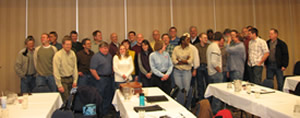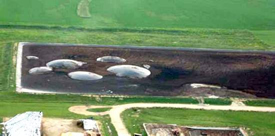On Tuesday, February 17, I had the good fortune to speak to engineers with or affiliated with the National Resources Conservation Service (NRCS) in St. Cloud, Minnesota. NRCS is part of the United States Department of Agriculture (USDA).
I spoke on the first afternoon of the 2.5-day annual event along with environmental engineer Cherie LaFleur (NRCS, Dallas-Fort Worth). Cherie seems to be taking up the mantle for NRCS on geosynthetic issues. With so many sites, particularly animal waste containment operations, adopting geosynthetics, it�s becoming critically important to have more input from user groups, such as NRCS, in the geosynthetics community. We�re happy to welcome Cherie, her perspective and her questions.

THE AFTERNOON, IN BRIEF
John Brach, an education leader and state conservation engineer with NRCS� Saint Paul office, opened with a few remarks. John proved to be a gracious host and friend to all at the event.
Chief engineer Al Kean of the Minnesota Board of Water and Soil Resources (BWSR) updated the audience of about 60 engineers on BWSR�s activities, funding issues regarding Minnesota�s budget crisis, and the state�s rather healthy support for wetlands restoration and related initiatives.
Kurt Deter, a self-proclaimed �ditch lawyer� with the law firm Rinke-Noonan (St. Cloud), spoke with humor and ease about what is in fact a rather contentious issue: drainage law. He provided a 30-year perspective�and what a 30 years it has been! We’ve moved from an agriculture-first approach (drain everything) to a wetlands preservation-first approach. Watersheds, multiple agencies providing oversite, etc. Deter wondered what a farmer in the 1950s would have felt about someone approaching him with an offer (or order!) to flood his land and create a wetland.
 I followed Deter with a general �Lessons Learned� presentation regarding geomembrane containment for animal waste lagoons. John Brach preceded my portion of the afternoon with a note about the importance of failure for instruction; and, true enough, it was the images of whale failures of bottom liners that really grabbed attention. Minnesota has not had many incidents of these natures, but that, more than anything, was the reason for discussion. Minnesota does not want these situations. I was very happy to have the opportunity to speak to this group, and I�m thankful for their kindness. The most important notes I hope they took away (from an admittedly too-full-for-its-timeslot presentation) are that (a) one should think about lining systems, not just about a single liner; (b) in the immediate, one should design for managing leakage (rather than assume that an �impermeable� membrane can never leak); (c) stresses and loads on a liner should be minimized; (d) expert installation work should be used whenever possible and proper post-construction liner integrity checks (e.g., leak location surveys) are advisable; and (e) for the long-term health of a system, one should more carefully consider how the additive packages and polymers of particular manufacturers� geomembranes may satisfy the reasonable service life expectations of a facility. This last point is something that all engineers should talk to manufacturers about. Two 30-mil reinforced polypropylene geomembranes (or 40-mil HDPE liners, etc.) from different manufacturers�and possibly from the same manufacturer�are not necessarily the same. They will not necessarily perform the same in like environments. They are designed for particular performance bars. One should increase this dialogue so that appropriate lifetimes are understood and the fitting materials are specified.
I followed Deter with a general �Lessons Learned� presentation regarding geomembrane containment for animal waste lagoons. John Brach preceded my portion of the afternoon with a note about the importance of failure for instruction; and, true enough, it was the images of whale failures of bottom liners that really grabbed attention. Minnesota has not had many incidents of these natures, but that, more than anything, was the reason for discussion. Minnesota does not want these situations. I was very happy to have the opportunity to speak to this group, and I�m thankful for their kindness. The most important notes I hope they took away (from an admittedly too-full-for-its-timeslot presentation) are that (a) one should think about lining systems, not just about a single liner; (b) in the immediate, one should design for managing leakage (rather than assume that an �impermeable� membrane can never leak); (c) stresses and loads on a liner should be minimized; (d) expert installation work should be used whenever possible and proper post-construction liner integrity checks (e.g., leak location surveys) are advisable; and (e) for the long-term health of a system, one should more carefully consider how the additive packages and polymers of particular manufacturers� geomembranes may satisfy the reasonable service life expectations of a facility. This last point is something that all engineers should talk to manufacturers about. Two 30-mil reinforced polypropylene geomembranes (or 40-mil HDPE liners, etc.) from different manufacturers�and possibly from the same manufacturer�are not necessarily the same. They will not necessarily perform the same in like environments. They are designed for particular performance bars. One should increase this dialogue so that appropriate lifetimes are understood and the fitting materials are specified.
Cherie LaFleur followed with a discussion of venting system analysis and the effects of gas generation beneath a geomembrane. Minnesota, she found, is a state with a high level of organic soils. Many of the animal waste lagoon installations happen directly over this soil (whether new lagoons or fitting them to older drainage pits); and, to judge by audience comments, geotextiles seem to have been the most common form of separation (cushion/drainage/venting) layer between the geomembranes and earth. Cherie offered numbers to support how heavier geotextiles (such as 16 oz rather than 8 oz) can provide a higher factor of safety, and that perhaps a more conservative approach is desired in this sector. She also passed around geonet and geocomposite samples as an alternative drainage/venting system solution.
While attendees were interested in alternative (and more conservative) designs, they were also hoping to learn more of a failure in Michigan they were aware of. That failure has been reported to have used more drainage and venting controls than the typical failure, yet no explanation�that we knew of in this group�has been offered. Such situations could give one pause for moving to new (and perhaps costlier) designs, even if the factor of safety is higher.
The day ended with engineer Kim Brynildson�s update on the Minnesota Pollution Control Agency�s (MPCA) Feedlot Program. She reports that she is seeing very few applications for open pit storage at the moment. Nearly all applications for manure management are concrete storage beneath CAFO barns. Even silage runoff is being collected and disposed of in those manure facilities.
An educational afternoon, indeed. Thank you Cherie for the invitation, John Brach for hosting, fellow speakers for your contributions, and all of the engineers for their time.
Chris Kelsey is geosynthetica.net’s editorial director. He may be reached at chris@geosynthetica.net.











